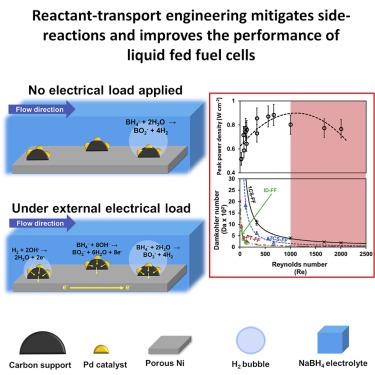Cell Reports Physical Science ( IF 7.9 ) Pub Date : 2020-06-17 , DOI: 10.1016/j.xcrp.2020.100084 Zhongyang Wang , Shrihari Sankarasubramanian , Vijay Ramani

|
The development of high-power fuel cells could advance the electrification of the transportation sector, including marine and air transport. Liquid-fueled fuel cells are particularly attractive for such applications as they obviate the issue of fuel transportation and storage. Here, we report a direct borohydride fuel cell (DBFC) for high-power propulsion applications that delivers ∼0.9 W cm−2 peak power by using a pH gradient-enabled microscale bipolar interface (PMBI) to effectively meet the incongruent pH requirements for borohydride oxidation/peroxide reduction reactions. Reactant-transport engineering of the anode flow field architecture and fuel flowrates mitigates parasitic borohydride hydrolysis and hydrogen oxidation reactions and lessens anode passivation by hydrogen bubbles. We identify an optimal flow regime range, broadly applicable to other liquid-fed fuel cells, in terms of the standard dimensionless Reynolds number (Re) and the Damkohler number (Da). DBFCs fulfilling these criteria provide a 2.4 times higher power density at 1.5 V compared to state-of-the-art polymer electrolyte membrane fuel cells (PEMFCs) that typically operate at 0.75 V. The high peak power density of 890 mW cm−2 at 1.1 V may offer a pathway to reduce fuel cell stack size for propulsion applications.
中文翻译:

高功率直接硼氢化物燃料电池的反应物运输工程方法
大功率燃料电池的开发可以促进包括海洋和航空运输在内的运输部门的电气化。液体燃料电池对于此类应用特别有吸引力,因为它们消除了燃料运输和存储的问题。在这里,我们报告了一种用于高功率推进应用的直接硼氢化物燃料电池(DBFC),其输出功率约为0.9 W cm -2通过使用支持pH梯度的微尺度双极界面(PMBI)来最大程度地提高功率,以有效满足硼氢化物氧化/过氧化物还原反应的不一致pH要求。阳极流场结构和燃料流量的反应物传输工程减轻了寄生的硼氢化物水解和氢氧化反应,并减少了氢气泡引起的阳极钝化。我们根据标准无量纲雷诺数(Re)和达姆霍勒数(Da)确定了一个广泛适用于其他液体燃料电池的最佳流动状态范围)。满足这些标准的DBFC在1.5 V时提供的功率密度是通常在0.75 V下运行的现有技术的高分子电解质膜燃料电池(PEMFC)的2.4倍。峰值功率密度为890 mW cm -2。 1.1 V可能会为减少推进应用中的燃料电池堆尺寸提供一条途径。











































 京公网安备 11010802027423号
京公网安备 11010802027423号